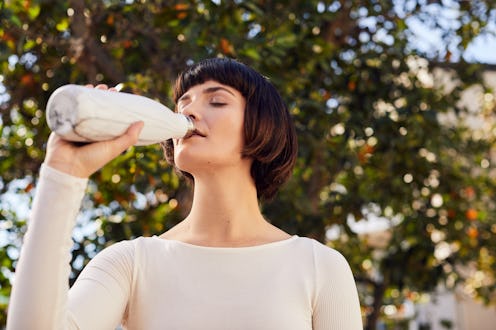
No matter what medical issue you’re dealing with, the advice is usually to drink more water. In fact, a lot of health advice makes water sound like some magic elixir you can’t have enough of. And water is absolutely necessary to survive. But what you're not often told is that you can have too much of a good thing, drinking water included.
“We're constantly being told the benefits of regularly drinking water, and more often than not, these benefits stand true,” Morgan Statt, Health and Safety Investigator at ConsumerSafety.org, tells Bustle. “From boosting your immune system to clearing your skin, you'd be hard-pressed to find something water doesn't help with. But, unfortunately, it is possible to drink too much water.”
Statt warns against drinking more than 27 to 33 fluid ounces (about three and a half to four cups) per hour. This could cause your blood sodium levels to drop dangerously low, which leads to a condition called hyponatremia. Symptoms include fatigue, vomiting, confusion, headaches, and sometimes death. While this condition is usually associated with elite athletes or hardcore exercise, it's also a possible side effect of medications like antidepressants, according to the National Kidney Foundation, or underlying health conditions. It's worth checking in with your doctor if you think you have any of those symptoms.
The effects of drinking too much water are usually not this severe, but they can be disruptive. Here are some signs that you could be drinking too much water or other fluids:
1You’re Peeing All. The. Time.
Frequent urination is a pain. It can interrupt long-awaited friend hangs, or worse, your precious sleep. And while it can stem from a number of medical issues, the most common cause is actually drinking too much water, Dr. Sangeeta Mahajan, M.D., a urogynecologist at the University Hospital Case Medical Center, tells Bustle. If you’re peeing more than seven times day, dial back your water consumption and see if the problem goes away. If your issue is constantly getting up to pee at night, try being especially mindful to drink less before bed.
2Your Pee Is Clear
Dark yellow pee is a bad sign, but so is completely colorless pee, says Statt. Ideally, your pee should be light yellow. According to UC San Diego Health, transparent urine might suggest you're drinking too much water and diluting crucial electrolytes. If your urine is dark yellow, however, you might want to actually consider drinking more water.
3You’re Getting Cramps
Peeing too much because you can't put down the Nalgene can lead to a loss of potassium, a mineral that helps your body contract and relax your muscles, says Statt. Without it, you might notice yourself more easily cramping, and the Mayo Clinic's page on hyponatremia symptoms backs this up. Potassium is an electrolyte, and when you're constantly flushing out your body, you can lose too much of it.
4You’re Fatigued
If you're drinking so much water that it leads to hyponatremia, you might experience fatigue, Statt says. The National Kidney Foundation says that treating this sodium imbalance may just mean cutting back on water, or having certain medications adjusted. It's always worth talking to your doctor if you have fatigue that's not normal for you.
5Your Hands & Feet Are Swollen
A little bit of bloating is common once in a while — if you ate a lot of salty foods, for example. In that case, your body would retain water to dilute it. But swelling due to over-hydration is a whole other story. When your blood sodium levels are imbalanced, fluids may rush to correct them, leading to swelling in your hands and feet, Statt adds. This situation, called fluid overload, can be dangerous, but it's typically the result of an underlying health issue, not simply drinking more water in and of itself.
6Headaches
Sodium imbalances resulting from over-hydration can also fill your cells with fluids, leading your brain to swell, says Statt. This puts pressure on your skull, which can lead to a headache. In fact, according to a 2018 report published in the Kidney International Reports journal, studies have shown that "hyponatremia carries a significant risk of neurological impairment," even if brain swelling doesn't occur.
7Drinking When You're Not Thirsty
Thirst is the best indicator that you need water, Statt explains. One 2014 study in the Proceedings of the National Academy of Sciences found that our swallow reflex diminishes once we've had enough to drink. So, lack of thirst could mean you've hydrated enough. That being said, the National Academies of Sciences, Engineering, and Medicine recommends women drink 2.7 liters of water each day and that men drink 3.7 liters each day.
Many of these signs don't indicate over-hydration in of themselves, so talk about your urine color and the frequency with which you're going to the bathroom with your doctor.
Studies referenced:
Gankam Kengne, F. and Decaux, G. (2018). Hyponatremia and the Brain. Kidney International Reports, 3(1), pp.24-35. Available at: https://www.ncbi.nlm.nih.gov/pmc/articles/PMC5762960/
Saker, P., Farrell, M. J., Adib, F. R. M., Egan, G. F., Mckinley, M. J., & Denton, D. A. (2014). Regional brain responses associated with drinking water during thirst and after its satiation. Proceedings of the National Academy of Sciences, 111(14). doi: 10.1073/pnas.1403382111
Sources interviewed:
Morgan Statt, Health and Safety Investigator at ConsumerSafety.org
Dr. Sangeeta Mahajan, MD, urogynecologist at the University Hospital Case Medical Center
This article was originally published on